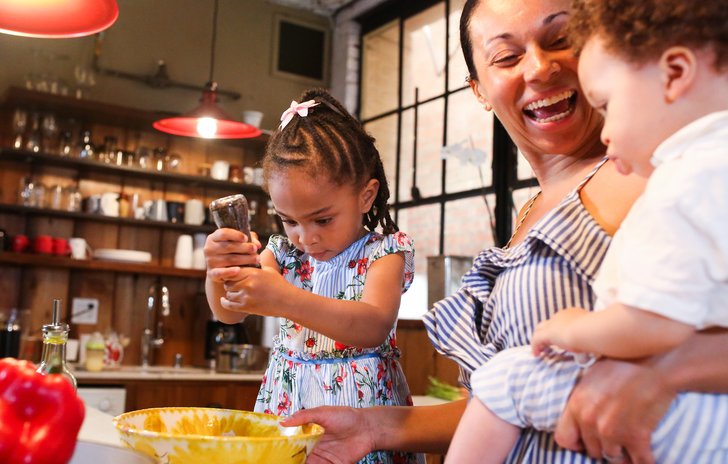Talking about food is a great way to get children chatting, sharing their opinions, learning new words, and learning about keeping healthy too!
Top tips for positive conversations about food:

- When time allows, eat meals together as a family. Meal times are a great time to chat about anything and everything, and this can include the food you're eating. Your child will be more likely to try new foods if they see you eating them, and you'll be teaching them how to use a knife and fork too.
- When you talk about healthy foods, and not so healthy foods, refer to them as foods you should eat more often or less often, rather than good or bad foods.
- Make food fun, involve your child in food shopping, preparation, and maybe even a bit of growing!
- Talk to your child about why it's important to eat different types of food. Link what they're eating to the energy and nutrition they need for their brain to work well, to grow and to play.
- Be aware of your own views and feelings about food, and try not to talk about food in a negative way when your child is nearby.

Games and activities to get them chatting about food:
Draw or stick your own plate of food
Talk to your child about foods they like. Look for pictures in a magazine (supermarkets often have free food magazines), help your child cut them out and stick them to a paper plate (or circle of paper). Or encourage them to draw pictures instead. They can include foods they would like to try, or maybe even make-believe foods.
Veggie - What's in the bag?
Put some hard vegetables in a bag. Then take it in turns to put your hand in the bag and choose a vegetable. Gently feel the vegetable and describe it's shape and texture. Take it in turns to see if you or your child can guess the vegetable.
Guess that food
A game you can play anywhere.
Think of a food and give your child clues to help them guess what food you're thinking of. For example; they come in a tin, they're in a red sauce, there's lots of them ... baked beans.
As children get older you can change the game to make it a little more challenging. Invite your child to ask you questions to work out what food you're thinking of, but you can only give yes/no answers. For example, is it sticky? does it grow on a tree?
Alphabet foods
At a meal time, in the car, or on the bus, chat about foods as you work together to try and name a food for each letter of the alphabet.
For example A is for apple, B is for banana, C is for cucumber, D is for ... (this is a good opportunity to practice saying the letter sounds rather than the letter names too).
Stories to get them chatting about food:
Books and stories are a great way to get children chatting about their food likes, dislikes and more. Visit the library and see if you can find any of these titles, or ask the librarian to help you find other books about food.
Barty's Ketchup Catastrophe By Sally Chambers Barty wouldn't eat anything without ketchup. But then one day Barty was at his friends house and catastrophe struck ... there was NO ketchup!
Supertato By Sue Hendra & Paul Linnet Meet Supertato! He's the supermarket superhero with eyes everywhere - but now there's a pea on the loose. A very, very naughty pea. Has Supertato finally met his match?
Baby Goes to Market By Atinuke As Mama and Baby wend their way through the market stalls, cheeky Baby collects five juicy oranges, four sugary chin-chin biscuits, three roasted sweetcorn, two pieces of coconut ... until Mama notices that her basket is getting very heavy.
Oliver's vegetables By Vivian French Do you like chips? Oliver does. In fact, he won't eat anything else - until he plays a game with his grandpa. Whatever vegetable Oliver finds in the garden, he must eat. On Monday, he pulls up carrots, on Tuesday, it is spinach . . .
Can You Eat? By Joshua David Stein Can you eat... A pea? A pear? A bee? A bear? This book asks the question, "Can you eat...?" followed by a lyrical list of illustrated items. From familiar items like apple pie and pineapple to the more nonsensical, like underpants and elephants!
Feast for Ten By Cathryn Falwell Count from one to ten--then count again! What does it take to make a feast for ten hungry people? Shopping, cooking, setting the table--everyone in this loving family pitches in to create a colourful and joyful feast.
I will not ever Never eat a tomato By Lauren Child Lola says, I do not eat peas or carrots or potatoes or mushrooms or spaghetti or eggs or saussages. I do not eat cabbage or baked beans or bananas or cauliflower or oranges. And I ABSOLUTELY will not ever NEVER eat a tomato.
Good to know
Talking about foods will support your child's knowledge and make them feel more relaxed and confident about trying new foods, as well as developing their vocabulary and thinking skills.
For more information and advice about food for babies and children visit the British Nutrition Foundation or Tiny Happy People.




